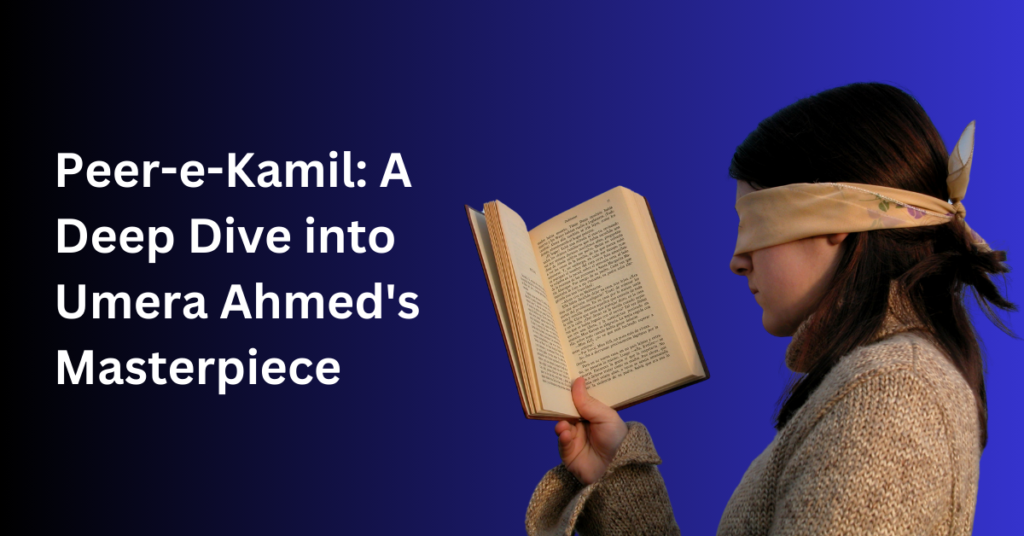Umera Ahmed’s Peer-e-Kamil (The Perfect Mentor) is one of the most widely read and revered Urdu novels in modern Pakistani literature. First published in 2004, this novel has captured the hearts of millions of readers with its gripping storyline, deep spiritual themes, and relatable characters. At its core, Peer-e-Kamil is a story of personal growth, redemption, and the transformative power of faith, set against the backdrop of a deeply divided society.
The Meaning of the Title: “Peer-e-Kamil”
The title Peer-e-Kamil holds profound significance. In Urdu, “Peer” refers to a spiritual mentor or guide, while “Kamil” means perfect. Combined, the title translates to “The Perfect Mentor.” This concept is central to the novel’s themes, as the characters embark on a spiritual quest for guidance, understanding, and inner peace. The title reflects the essence of the novel’s exploration of faith and spiritual perfection, and it invites readers to reflect on their own journeys towards enlightenment.
Plot Overview
Peer e Kamil PDF revolves around two main characters: Imama Hashim and Salar Sikander. Imama is a strong-willed, devout Muslim girl from an influential family, while Salar is a brilliant but rebellious young man with an IQ of 150, whose life is driven by materialistic desires and nihilistic behavior.
The novel begins with Imama’s internal struggle, as she decides to convert from her family’s sect of Islam to another sect that she believes to be true. This decision creates a rift between her and her family, who impose harsh restrictions on her, leading her to seek freedom and live her life on her own terms. On the other hand, Salar is portrayed as a self-destructive individual, indulging in reckless behavior and contemplating suicide. His encounter with Imama becomes the catalyst for the transformation of both characters, as they navigate through life’s challenges, rediscover their faith, and ultimately, find redemption.
Character Development
Imama Hashim: A Strong-Willed Heroine
Imama Hashim is a symbol of resilience and faith. Despite facing immense opposition from her family, she remains steadfast in her beliefs and decisions. Her spiritual quest is at the heart of the novel, as she seeks truth and inner peace. Imama’s journey highlights the struggles that many women face in patriarchal societies, especially when it comes to asserting their religious or personal choices.
Salar Sikander: A Journey of Redemption
Salar Sikander’s transformation is one of the most compelling aspects of Peer-e-Kamil. At the beginning of the novel, Salar is portrayed as an arrogant, wayward youth. His life takes a dramatic turn after he crosses paths with Imama, and through a series of life-altering events, he embarks on a journey of self-discovery and spiritual awakening. Salar’s eventual redemption through faith is a testament to the power of second chances and the possibility of personal growth.
Themes Explored in the Novel
Faith and Religion
One of the central themes in Peer-e-Kamil is faith. Umera Ahmed explores the importance of belief in shaping one’s identity and guiding one’s actions. Imama’s conversion to a different sect is a bold statement on the personal nature of faith, while Salar’s spiritual awakening underscores the idea that even those who have lost their way can find redemption through faith.
Self-Discovery and Personal Growth
Both Imama and Salar undergo significant personal growth throughout the novel. Imama’s journey is one of resilience and strength, while Salar’s transformation is a story of redemption. The novel emphasizes that true self-discovery often comes through trials and tribulations, and that growth is a lifelong process.
Love and Relationships
While Peer-e-Kamil is not a conventional love story, love plays an important role in the characters’ lives. The novel portrays love as a force that drives both personal and spiritual growth. Imama and Salar’s evolving relationship is not just romantic, but also deeply spiritual, as they learn to support and guide each other on their individual paths.
Religious Undertones in Peer-e-Kamil
The novel is rich with religious undertones, particularly in its representation of Islamic sects. Imama’s decision to change her sect is a bold move that brings her into conflict with her family and society. Umera Ahmed uses this conflict to explore larger questions about faith, belief, and the pressures of conforming to societal norms. Imama’s journey is a reflection of the broader struggle many people face in following their religious convictions in the face of opposition.
The Concept of a “Perfect Mentor”
The idea of a “Peer-e-Kamil” or a perfect spiritual guide is central to the novel’s theme of spiritual awakening. Both Imama and Salar are in search of guidance, and they find their “Peer” not in a single person, but in their own faith and the lessons they learn along the way. The novel suggests that the journey towards spiritual perfection is deeply personal and can only be achieved through sincere self-reflection and faith.
Transformation of Salar Sikander
Salar’s character arc is one of the most striking elements of the novel. Initially portrayed as a troubled and arrogant young man, Salar’s journey towards self-awareness and redemption is both painful and inspiring. After a near-death experience, Salar begins to question his life choices and seeks a deeper understanding of himself and his faith. His transformation from a reckless youth to a devout believer is a powerful narrative of personal growth and spiritual enlightenment.
Imama’s Struggles and Resilience
Imama’s journey is a testament to the strength of the human spirit. Her decision to stand up for her beliefs, even at the cost of losing her family and societal status, makes her one of the strongest characters in modern Urdu literature. Imama’s resilience in the face of adversity serves as an inspiration for readers, particularly women, who may find themselves in similar situations of conflict between personal beliefs and societal expectations.
Love Story vs. Spiritual Quest
While Peer-e-Kamil does contain elements of romance, the love story between Imama and Salar is intertwined with their spiritual quests. Their relationship evolves as they grow individually, and their love becomes a reflection of their shared spiritual journey. Umera Ahmed masterfully balances the romantic and spiritual elements of the story, showing that true love is not just about emotional connection, but also about mutual growth and understanding.
Cultural and Social Commentary
Peer-e-Kamil provides a rich commentary on the cultural and social norms prevalent in Pakistani society. Umera Ahmed delves deep into issues like family expectations, societal pressure, and the rigid frameworks of religion and tradition. Through Imama’s struggles with her family, the novel explores the oppressive nature of familial control, especially on young women, when it comes to personal choices—be it in matters of faith, marriage, or career.
Umera Ahmed critiques the tendency of families to impose their beliefs on their children, as seen with Imama’s family. Her defiance against their wishes reflects the challenges faced by individuals who try to break free from conservative structures to forge their own paths. Similarly, Salar’s rebellious nature can be seen as a reflection of young people’s frustration with societal norms that don’t align with their personal values.
This commentary is significant because it highlights the tensions that exist between individual autonomy and societal conformity, making the novel highly relatable for readers, particularly in South Asia, where family and society hold immense influence over personal decisions.
Language and Writing Style
One of the most beautiful aspects of Peer-e-Kamil is Umera Ahmed’s writing style. The novel is written in Urdu, which adds depth and cultural resonance to the story. The use of simple, everyday language makes the novel accessible to a wide audience, yet it retains a lyrical quality that elevates the emotional and spiritual themes. Umera Ahmed’s skillful blend of prose and poetry, particularly the insertion of poetic verses and Quranic references, gives the novel a spiritual and contemplative tone.
Her ability to weave complex emotional and spiritual dilemmas into straightforward yet impactful prose is one reason why Peer-e-Kamil has touched so many hearts. The dialogues between characters feel natural and genuine, while the internal monologues give readers a deep insight into the characters’ inner worlds.
Impact of Peer-e-Kamil on Readers
One of the reasons Peer-e-Kamil resonates so deeply with its readers is because of the emotional and spiritual journey it offers. Many readers connect with Imama’s faith-driven resilience and Salar’s transformative redemption. The novel encourages self-reflection, prompting readers to think about their own lives, relationships, and faith.
For young adults, especially those navigating the pressures of family, society, and personal beliefs, Peer-e-Kamil serves as both a mirror and a guide. It speaks to the modern struggles of faith in a world that often prioritizes material success over spiritual fulfillment. The novel’s depiction of personal growth and spiritual awakening resonates particularly with readers who are on their own quests for meaning and purpose.
In Pakistan and other Urdu-speaking communities, Peer-e-Kamil has become a cultural phenomenon. The novel is often discussed in literary circles, and its themes have sparked conversations about faith, societal expectations, and the importance of spiritual mentors. It has also inspired many readers to revisit their own beliefs and relationships, making it more than just a piece of fiction—it’s a guide to living a more purposeful life.
Critical Reception
Peer-e-Kamil has been lauded by critics and readers alike for its depth, emotional resonance, and complex character development. It’s not just seen as a love story or a spiritual novel—it’s appreciated for how it brings together multiple layers of narrative that are at once personal and universal.
Critics have praised Umera Ahmed for tackling sensitive issues related to religious sects and faith with care and respect. The novel’s exploration of a woman’s right to choose her faith and a man’s journey of redemption through faith have been considered bold, especially in a conservative society.
The novel has also been applauded for its strong, independent female lead. Imama Hashim is seen as a role model for many women, showing that it’s possible to stand up for what you believe in, even when faced with immense opposition.
The emotional depth of Salar Sikander’s character arc has also been a point of critical discussion. His complex personality, coupled with his drastic transformation, is seen as a representation of how individuals can change and redeem themselves, no matter how far gone they may seem.
Conclusion
Peer-e-Kamil is not just a novel—it’s an emotional and spiritual experience that leaves a lasting impact on its readers. Umera Ahmed’s masterful storytelling, rich characters, and deep exploration of faith, love, and redemption make it a timeless piece of literature. The journey of Imama and Salar is one of resilience, personal growth, and spiritual enlightenment, resonating with anyone who has ever struggled with their identity, faith, or place in society.
Umera Ahmed has earned her place among the greats of modern Urdu literature with Peer-e-Kamil, a novel that will continue to inspire and guide readers for generations to come. It stands as a testament to the transformative power of faith and the importance of personal growth in the face of adversity.
FAQs
What is the main theme of Peer-e-Kamil?
The central theme of Peer-e-Kamil is the journey of self-discovery and spiritual growth. The novel delves into the power of faith, redemption, and the personal quest for truth, as experienced by the two main characters, Imama and Salar.
Why is Peer-e-Kamil considered a spiritual novel?
Peer-e-Kamil is considered a spiritual novel because it revolves around the characters’ quests for spiritual enlightenment and understanding of their faith. It explores themes of religious devotion, personal growth, and the transformative power of belief.
How does Salar Sikander change throughout the story?
Salar Sikander undergoes a significant transformation. Initially portrayed as an arrogant and reckless youth, his life takes a drastic turn after a near-death experience. Through his journey of self-reflection and faith, Salar transforms into a more grounded, devout individual who finds redemption and purpose.
What role does faith play in Peer-e-Kamil?
Faith is at the heart of Peer-e-Kamil. It drives the characters’ decisions, actions, and personal transformations. The novel explores the complexities of religious belief, the personal nature of faith, and the challenges that come with pursuing one’s spiritual convictions.
Is Peer-e-Kamil based on a true story?
No, Peer-e-Kamil is a work of fiction. However, its themes of faith, personal growth, and societal pressures are deeply relatable, which is why many readers feel a personal connection to the story and its characters.



